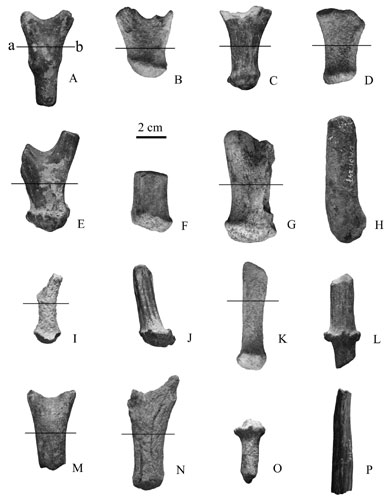| Location: Home > Research > Research Progress |
| New Cervid Species Found in Middle Miocene of Nei Mongol, China |
|
WANG Li-Hua, a graduate student paleontologist from Institute of Vertebrate Paleontology and Paleoanthropology, Chinese Academy of Sciences, identified a new species of cervid, Euprox altus, from the Middle Miocene fossil locality of Damiao (N42°00’31.4’’, E111°34’50’’), Siziwangqi, Nei Mongol, as reported in the latest issue of Vertebrata PalAsiatic 2011(4). Its tooth morphology and comparison with other species suggest that during the latest Middle Miocene the Damiao area was a warm and humid environment. Euprox was named by Stehlin in 1928 when he studied fossil cervids from Steinheim in Germany. This new speccies is a small Euprox species, having two-tined antlers with prominent burrs. The fork of the antler starts high above the true burr. The antler surface is ornamented unevenly with longitudinal grooves. The cheek teeth are brachyodont. The fold on the postprotocrista of P4 is developed. The precingulum, entocingulum and postcingulum are present and linked together on the upper molars. The palaeomeryx fold is present but weak on the lower molars. Tooth morphology and comparison with other species suggest that during the latest Middle Miocene the Damiao area was a warm and humid environment. The finding of Euprox altus indicats that during the latest Middle Miocene the monsoon, which produced a dry and strongly seasonal climate, had not yet formed or had not influenced the Damiao area at least. “The American Museum of Natural History’s Central Asiatic Expeditions of the early 20th century, led by R. C. Andrews, discovered rich fossil mammals in Nei Mongol, including the Tunggur fauna, representative fauna of the Chinese Middle Miocene Tunggurian age. They found some Euprox antler material. During the field seasons from 2006 to 2009, we found a total of 34 mammalian fossil localities near Damiao village”, said Dr. ZHANG Zhao-Qun, co-author and the research designer, “Richest among these was a Middle Miocene locality, DM01, produced many antlers and teeth. These antlers differ from those of other known Euprox species, representing a new form of Euprox.”
Fig.1: Antlers of Euprox altus sp. nov. from the Middle Miocene fossil locality of Damiao, Siziwangqi, Nei Mongol (Images by WANG Li-Hua)
Fig.2: Cheek teeth of Euprox altus sp. nov. (in occlusal view) from the Middle Miocene fossil locality of Damiao, Siziwangqi, Nei Mongol (Images by WANG Li-Hua) |

